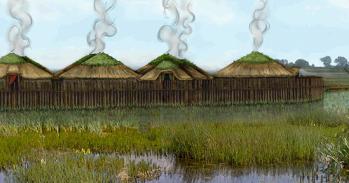In the final report of our Egg Cetera series on egg-related research, archaeologist Brian Stewart investigates a remarkable technological leap for early mankind – the use of ostrich eggshells as water carriers.
In the final report of our Egg Cetera series on egg-related research, archaeologist Brian Stewart investigates a remarkable technological leap for early mankind – the use of ostrich eggshells as water carriers.
Ethnographic research teaches us that recent and modern hunter-gatherers in another arid environment of southern African – the Kalahari Desert – use ostrich eggshells as water flasks.
South Africa’s Richtersveld coastal desert is a thirsty place. Some rain falls in winter – but not much. Most of the year plants and animals depend on the coastal fogs that develop as the warm desert air meets the cool upwelled waters of the southern Atlantic. To work there, we needed to take all our food with us and relied on a 500-litre plastic water drum strapped to our 4x4, driving two hours to the nearest town to refill it every ten days. It’s an environment populated by a huge variety of reptile and insect life, including cockroaches the size of Amazon’s Kindle.
Yet hunter-gatherers survived in this and other arid regions of southern Africa for tens of thousands of years without conveniences like Land Rovers or plastic containers. How did they do it? This is what our team of archaeologists from the Universities of Cambridge and Toronto travelled to Sub-Saharan Africa to find out: how early members of our species, and perhaps even earlier hominins, colonised and made a living in marginal environments like the sub-arid Richtersveld.
The answers lie in the fragments of ostrich eggshell buried in 60,000 years’ worth of silty archaeological deposits trapped by the natural rock-shelter – called Spitzkloof A – that we excavated. Each day we uncovered hundreds of pieces of shell. Ethnographic research teaches us that recent and modern hunter-gatherers in another arid environment of southern African – the Kalahari Desert – use ostrich eggshells as water flasks.
Kalahari Bushmen gather eggs from ostrich nests (a risky exercise given the speed, strength and notoriously foul temper of these largest birds on earth). They empty the contents of the egg through a hole drilled in one end and use this opening as the spout through which to pour water for drinking, transport and storage. Ostrich eggshells are brilliant flasks – they’re robust, not too large (1 litre on average) and breathable, so water stays cool. As such, they were valued objects for both Kalahari Bushmen and prehistoric groups.
Clusters of whole ostrich eggshell flasks (with grass or beeswax stoppers to prevent spillage) have been found stashed in the arid landscapes of southwest Africa and, as at Spitzkloof, fragments are found in the earliest archaeological deposits to occur in these areas. Although spout rim fragments are rare, it is probable that the innovation of using ostrich eggshells as water flasks allowed humans to live in sub-Saharan Africa’s driest areas, such as the Richtersveld.
Flasks were sometimes decorated with patterns engraved or painted on their surfaces. In the Kalahari this typically denotes ownership, but over the great depths of prehistoric time these patterns may have held many meanings. Once the flasks had broken, fragments were ground down and perforated to form beads (or pendants) to be strung as necklaces and bracelets and sewed onto clothing. Among Kalahari Bushmen, these beads become the focus of intricate and often long-distance exchange networks that bound people together in an uncertain landscape.
Ostrich eggshell beads made their appearance in the southern African archaeological record some 40,000 years ago, but decorated eggshell fragments have an even older pedigree. The Spitzkloof fragments, including those from the earliest levels, came in many colours, including black, beige, yellow, orange, teal and even bright red. Much of this discolouration was certainly unintentional, but some may have been purposeful.
At a site called Diepkloof, about 500 km south of Spitzkloof, archaeologists have uncovered 60,000 year-old ostrich eggshell flask fragments with clear engravings. Precisely what they meant for their makers is unknown, but together with 60–90,000-year-old finds from other African sites, these eggshell fragments are among the world’s earliest evidence for abstract thought, and thus ways of behaving that resemble our own.
People were decorating for eggs long before Easter, and Kindle-sized cockroaches or not, we’ll keep hunting for them.
Dr Brian Stewart
Brian Stewart is from the McDonald Institute for Archaeological Research, an interdisciplinary centre for archaeology within the University of Cambridge’s Department of Archaeology and Anthropology. His research explores early modern human adaptations to challenging landscapes in southern Africa, with particular emphasis on the coping mechanisms these hunter-gatherers employed in the face of frequent climatic fluctuations between 100,000 and 10,000 years ago. Brian’s work has received funding from the British Academy, the Wenner-Gren Foundation for Anthropological Research, the Natural Environment Research Council, the Prehistoric Society and the McDonald Institute for Archaeological Research
This work is licensed under a Creative Commons Licence. If you use this content on your site please link back to this page.





